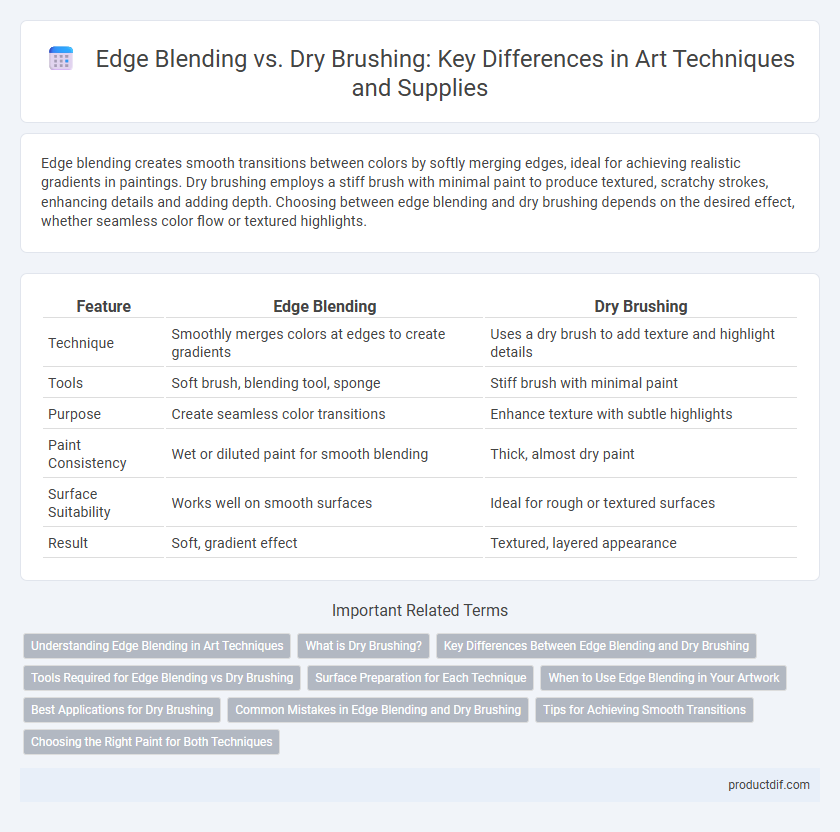Edge blending creates smooth transitions between colors by softly merging edges, ideal for achieving realistic gradients in paintings. Dry brushing employs a stiff brush with minimal paint to produce textured, scratchy strokes, enhancing details and adding depth. Choosing between edge blending and dry brushing depends on the desired effect, whether seamless color flow or textured highlights.
Table of Comparison
| Feature | Edge Blending | Dry Brushing |
|---|---|---|
| Technique | Smoothly merges colors at edges to create gradients | Uses a dry brush to add texture and highlight details |
| Tools | Soft brush, blending tool, sponge | Stiff brush with minimal paint |
| Purpose | Create seamless color transitions | Enhance texture with subtle highlights |
| Paint Consistency | Wet or diluted paint for smooth blending | Thick, almost dry paint |
| Surface Suitability | Works well on smooth surfaces | Ideal for rough or textured surfaces |
| Result | Soft, gradient effect | Textured, layered appearance |
Understanding Edge Blending in Art Techniques
Edge blending in art techniques involves smoothly transitioning colors or tones at the boundaries of different areas to create a seamless gradient, enhancing depth and realism. This method relies on controlled mixing of wet paint or soft layering to avoid harsh lines, often used in portrait painting, landscapes, and airbrushing. Mastery of edge blending allows artists to achieve subtle shifts in light and shadow, which are crucial for naturalistic and dimensional effects.
What is Dry Brushing?
Dry brushing is a painting technique where a small amount of paint is applied to a dry brush, then lightly dragged across a textured surface to highlight raised details and create a weathered or textured effect. This method is especially popular in miniature painting, model making, and fine art to emphasize edges and add depth without fully covering the base layer. Dry brushing requires minimal paint and a stiff-bristled brush to achieve subtle highlights and enhance the texture of the artwork.
Key Differences Between Edge Blending and Dry Brushing
Edge blending in art supply techniques involves seamlessly merging colors or tones at their borders to create smooth transitions, enhancing depth and cohesion in paintings. Dry brushing, conversely, uses a minimal paint amount on a dry brush to create textured, scratchy effects emphasizing surface details and highlights. The key differences lie in edge blending's focus on softness and gradient creation, while dry brushing prioritizes texture and accentuation of fine elements.
Tools Required for Edge Blending vs Dry Brushing
Edge blending requires soft blending brushes, sponges, or airbrushes to achieve smooth transitions between colors or tones, ensuring a seamless gradient effect. Dry brushing utilizes stiff bristle brushes or fan brushes with minimal paint to create textured, feathery strokes that highlight surface details and emphasize texture. Selecting the right tools significantly impacts the finish, with edge blending tools prioritizing softness and subtlety, while dry brushing tools emphasize texture and contrast.
Surface Preparation for Each Technique
Edge blending requires a smooth, primed surface to ensure seamless transitions between colors, which enhances the gradient effect. Dry brushing works best on textured or rough surfaces, allowing the brush to catch raised areas and create natural highlights. Proper surface preparation for each technique maximizes paint adhesion and overall finish quality.
When to Use Edge Blending in Your Artwork
Edge blending is ideal for creating smooth transitions between colors and tones, especially in landscapes and portrait painting where realism and subtle shading are required. It helps to eliminate harsh lines, achieving a soft gradient effect that enhances depth and dimension. Use edge blending when your artwork demands seamless color integration for a polished and cohesive finish.
Best Applications for Dry Brushing
Dry brushing is best suited for creating textured effects and highlighting raised surfaces on acrylic and oil paintings, particularly in miniature and model painting. This technique excels in accentuating fine details without overpowering base colors, making it ideal for weathering and adding depth to terrains or figures. Artists use dry brushing to achieve subtle gradients and worn looks that are difficult to replicate with edge blending.
Common Mistakes in Edge Blending and Dry Brushing
Common mistakes in edge blending include over-blending, which can muddy colors and reduce texture definition, and failing to use gradual pressure transitions, resulting in harsh lines instead of smooth gradients. In dry brushing, applying too much paint or using a brush that is too wet often leads to streaky, uneven coverage that obscures fine details. Both techniques require careful control of brush load and pressure to achieve the desired texture and depth in artwork.
Tips for Achieving Smooth Transitions
Achieve smooth transitions in edge blending by gradually layering colors with a soft brush while maintaining consistent paint dilution to avoid harsh lines. For dry brushing, use minimal paint on a nearly dry brush and apply light, sweeping strokes to build texture subtly without overwhelming adjacent areas. Mastering pressure control and brush angles in both techniques ensures seamless color integration and professional-quality finishes.
Choosing the Right Paint for Both Techniques
Selecting the right paint for edge blending involves using smooth, highly blendable acrylics or oils that allow seamless color transitions and soft gradients. For dry brushing, thicker, matte acrylic paints with low flow are ideal since they emphasize texture and create visible brush strokes without excessive blending. Understanding these paint properties ensures optimal results in both techniques, enhancing artistic expression and surface quality.
Edge Blending vs Dry Brushing Infographic

 productdif.com
productdif.com